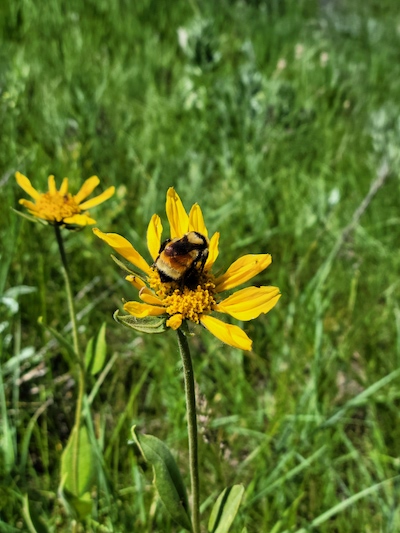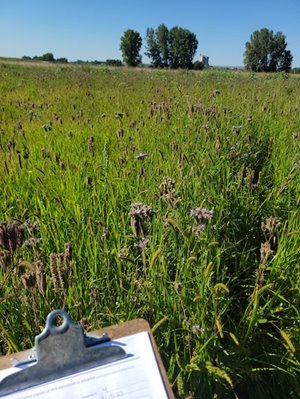Restoration efforts making progress at Lewis and Clark National Monument site
Pompeys Pillar National Monument is the only remaining on-site physical evidence of the Lewis and Clark Expedition. Located just 25 miles East of Billings, Mont., the property is managed by the Bureau of Land Management (BLM), where habitat restoration efforts are led by wildlife biologist Rebecca Newton in partnership with local Pheasants Forever employees.
“For the past 10-plus years we planted food plots in many of the fields at Pompeys. Then three to four years ago, the BLM started to replace food plots with native grass, in an effort to make the place look a little more like it would have looked when William Clark visited and carved his initials in the Rock,” said habitat specialist Steve Rockhold. “We started the transition in phases, gradually replacing food plots, and completed that process this spring.”
 About 35% of the world’s crops depend on pollinators, making their habitat crucial for a well-rounded and healthy ecosystem. Many plants cannot reproduce without the transportation of pollen, carried out by bees, butterflies and other pollinators as they move from plant-to-plant in search of food. Pollinators, along with other insects, also play an important role in the life cycle of upland birds. Chicks and young broods depend almost entirely on insects as their food source, and adult birds also utilize them as food throughout their life.
About 35% of the world’s crops depend on pollinators, making their habitat crucial for a well-rounded and healthy ecosystem. Many plants cannot reproduce without the transportation of pollen, carried out by bees, butterflies and other pollinators as they move from plant-to-plant in search of food. Pollinators, along with other insects, also play an important role in the life cycle of upland birds. Chicks and young broods depend almost entirely on insects as their food source, and adult birds also utilize them as food throughout their life.
At Pompeys Pillar, grass and pollinator patches made up of various species were planted across six different fields. In May, Newton and Pheasants Forever biologist Crystallaina White established virtual transects via mapping software in each field that would be used to monitor the progress.
On June 5, 2023, the first of three monitoring efforts was conducted. At that point in time, there was a minimal number of flowers in bloom, except for some early emergent species such as dandelion and field bindweed. However, various bee, moth and fly species were visiting these flowers. A total of 21 European honey bees were identified through the six transects. There were no bumble bees present and the total number of pollinators observed was 43.
The second transect was conducted on July 18, 2023, and was the peak of activity for overall pollinator species. There were a total of 417 pollinators identified, including 41 bumble bees and 103 honey bees. The main floral associations were lacy phacelia and white sweetclover — Specialists observed that bumble bees more often visited the lacy phacelia over the other floral options.
Bumble bees and honey bees tend to be attracted to bright colors in the yellow, blue, green and violet varieties. They cannot see orange, red or white, though they will be attracted to flowers with those colors via floral scent. Across these six fields, bumble bees mainly pollinated by color, while honey bees were more often found on white sweetclover. Observations indicated honey bees are more greatly attracted to floral scent than color.
 The third and final monitoring effort was conducted on August 24, 2023. A total of 265 pollinators were counted, 76 of which were bumble bees, while 112 were honey bees. At this time, the main floral blooms were sunflowers and white sweetclover, though some fields had minimal blooms present. Various hornet and wasp species were also observed, indicating these species are more active late in the growing season. The data revealed bumble bees visited sunflowers more often than white sweetclover, while honey bees were once again found more often on white sweetclover.
The third and final monitoring effort was conducted on August 24, 2023. A total of 265 pollinators were counted, 76 of which were bumble bees, while 112 were honey bees. At this time, the main floral blooms were sunflowers and white sweetclover, though some fields had minimal blooms present. Various hornet and wasp species were also observed, indicating these species are more active late in the growing season. The data revealed bumble bees visited sunflowers more often than white sweetclover, while honey bees were once again found more often on white sweetclover.
“This project is one more step toward returning the Pompeys Pillar Area of Critical Environmental Concern (ACEC) to a more native and diverse plant community to support wildlife and recreational values,” said Rebecca Newton with BLM. “With continued declines in many pollinator species, our emphasis on improving habitats for pollinators is important and timely. We were excited to see a couple of sensitive bumble bee species in the restoration areas during BLM's inventory and monitoring efforts this summer. We look forward to seeing results from Pheasant's Forever's and BLM's monitoring over the next couple of years, and our partnerships with Pheasants Forever and Montana Fish, Wildlife & Parks have been integral to implementing this work.”
A large portion of this land is also open to hunting, excluding the area within the momunent boundary. Header Image By Bureau of Land Management, Montana and the Dakotas